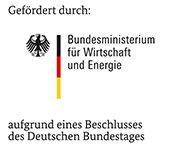321 ZBG

| Laufzeit: | 01.05.2009 - 30.04.2012 |
|---|---|
| Partner: | Frauenhofer IKTS Dresden |
| Geldgeber: | AiF |
| Bearbeiter: | S.K. Weidmann |
| Arbeitsgruppe: | Corrosion |
Motivation and Aim
Especially in aerospace industries a high corrosion resistance in combination with good adhesion properties for structural bonding is often required for the application of aluminium alloys. Chromic acid anodising (CAA) fulfils these demands but has to be replaced by less hazardous processes. Another common process to prepare aluminium alloys for structural bonding is phosphoric acid anodising (PAA). However, only CAA layers exhibit a sufficient corrosion resistance in the open porous state because hexavalent chromium is incorporated in the anodic oxide layer during anodising and acts as corrosion inhibitor. Sealing can enhance the corrosion resistance of anodic oxide but the standard sealing methods base on hydration and are not appropriate for sealing PAA layers since the phosphate ions incorporated into the oxide during anodising act as hydration barrier. Furthermore these sealing processes would close the pores and therefore lead to a loss of the good adhesion properties. The aim of this project was the improvement of the corrosion properties of PAA layers by a nanochemical impregnation. Additionally the pores should not be closed completely in order to preserve the good adhesion properties.
Approach
The parameters of the phosphoric acid anodisation should be adjusted to obtain large pores which allow a following impregnation without closing the pores completely. For the impreg-nation nanoparticulate commercially available dispersions and particulate and polymeric sols synthesized by sol-gel technology were applied. As coating methods electrophoretic deposition (EPD), dip coating and dip coating in combination with ultrasound were used.
Results
A modified phosphoric acid anodising (MPAA) process enabling the production of anodic oxide layers with pore diameters of around 100 nm has been developed by variation of the anodising parameters. The MPAA process is appropriate for several aluminium alloys and the parameters used are suitable for the industrial application. Commercially available SiO2 dispersions as well as particulate and polymeric SiO2 sols were used. The most promising results were obtained via dip coating with a commercially available dispersion since it leads to a filling of the bottom of the pores without closing the pores in the area near the surface of the anodic oxide layer. This impregnation is independent of moderate changes in the dip coating time and the temperature of the dispersion. By varying withdrawing rate and solids content of the dispersion the filling height can be regulated. In dependence of the pH value either only the pore bottom is filled with particles to a significant amount of the pore volume or additionally particles are deposited also in the near-surface part of the oxide layers without filling the pore volume there significantly. Basing on the experimental results a model to describe the particle deposition has been developed. The layer properties were investigated with electrochemical impedance spectroscopy and lap shear tests. The impedance measurements show that the impregnation does not lead to a direct enhancement of the barrier layer thickness but causes a healing of the barrier layer which should have a positive effect on the corrosion resistance. Up to now only a minimum lap shear strength could be determined because the samples exhibited a large plastic bending deformation and some even failed inside the base material (AA 1050). Consequently the properties of the base material and the bond can not be separated and the tests have to be repeated after adapting the entire process for aluminium alloys with higher strength. However, the minimum lap shear strength of the impregnated MPAA layers is comparable with the one of CAA layers and therefore the adhesion properties are very promising.
back

Das IGF-Vorhaben Nr. 321 ZBG der Forschungsvereinigung DECHEMA e.V., Theodor-Heuss-Allee 25, 60486 Frankfurt am Main wurde über die AiF im Rahmen des Programms zur Förderung der industriellen Gemeinschaftsforschung (IGF) vom Bundesministerium für Wirtschaft und Energie aufgrund eines Beschlusses des Deutschen Bundestages gefördert.
Contact |
| Prof. Dr.-Ing. Wolfram Fürbeth |
| Tel.: +49 69 / 75 64-398 E-mail: fuerbeth |
Publications |
| S.K. Weidmann, W. Fürbeth, O. Yezerska, U. Sydow, M. Schneider in: J. Hirsch, B. Skrotzki, G. Gottstein, Aluminium alloys: their physical and mechanical properties, Vol. 2, Wiley-VCH, Weinheim (2008) 2119-2124 |
| S.K. Weidmann, W. Fürbeth, O. Yezerska, U. Sydow, M. Schneider In: Jahrbuch Oberflächentechnik. Bd.65, Leuze, Saulgau/Württ. (2009) 206-222 |